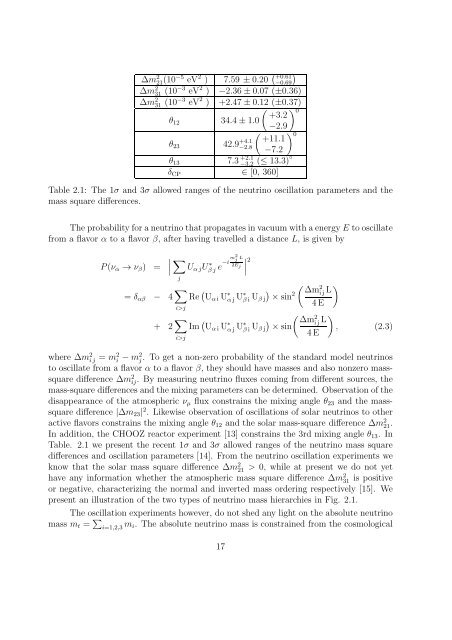PHYS08200604017 Manimala Mitra - Homi Bhabha National Institute
PHYS08200604017 Manimala Mitra - Homi Bhabha National Institute
PHYS08200604017 Manimala Mitra - Homi Bhabha National Institute
You also want an ePaper? Increase the reach of your titles
YUMPU automatically turns print PDFs into web optimized ePapers that Google loves.
∆m 2 21(10 −5 eV 2 ) 7.59 ±0.20 ( )<br />
+0.61<br />
−0.69<br />
∆m 2 31 (10 −3 eV 2 ) −2.36±0.07 (±0.36)<br />
∆m 2 31 (10 −3 eV 2 ) +2.47±0.12 (±0.37)<br />
( ) 0<br />
+3.2<br />
θ 12 34.4±1.0<br />
−2.9<br />
( ) 0<br />
+11.1<br />
θ 23 42.9 +4.1<br />
−2.8<br />
−7.2<br />
θ 13 7.3 −3.2 +2.1 (≤ 13.3)◦<br />
δ CP ∈ [0, 360]<br />
Table 2.1: The 1σ and 3σ allowed ranges of the neutrino oscillation parameters and the<br />
mass square differences.<br />
TheprobabilityforaneutrinothatpropagatesinvacuumwithaenergyE tooscillate<br />
from a flavor α to a flavor β, after having travelled a distance L, is given by<br />
P(ν α → ν β ) =<br />
∑<br />
∣ U αj Uβj ∗ j<br />
∣ L<br />
e−im2 2E j ∣∣<br />
2<br />
j<br />
= δ αβ − 4 ∑ Re ( (<br />
)<br />
U αi U ∗ αjU ∗ βiU βj ×sin<br />
2 ∆m<br />
2<br />
)<br />
ij L<br />
4E<br />
i>j<br />
+ 2 ∑ Im ( (<br />
U αi U ∗ αj U∗ βi U ) ∆m<br />
2<br />
)<br />
ij L<br />
βj ×sin , (2.3)<br />
4E<br />
i>j<br />
where ∆m 2 ij = m2 i −m2 j . To get a non-zero probability of the standard model neutrinos<br />
to oscillate from a flavor α to a flavor β, they should have masses and also nonzero masssquare<br />
difference ∆m 2 ij. By measuring neutrino fluxes coming from different sources, the<br />
mass-square differences andthe mixing parameters can bedetermined. Observation ofthe<br />
disappearance of the atmospheric ν µ flux constrains the mixing angle θ 23 and the masssquare<br />
difference |∆m 23 | 2 . Likewise observation of oscillations of solar neutrinos to other<br />
active flavors constrains the mixing angle θ 12 and the solar mass-square difference ∆m 2 21 .<br />
In addition, the CHOOZ reactor experiment [13] constrains the 3rd mixing angle θ 13 . In<br />
Table. 2.1 we present the recent 1σ and 3σ allowed ranges of the neutrino mass square<br />
differences and oscillation parameters [14]. From the neutrino oscillation experiments we<br />
know that the solar mass square difference ∆m 2 21 > 0, while at present we do not yet<br />
have any information whether the atmospheric mass square difference ∆m 2 31 is positive<br />
or negative, characterizing the normal and inverted mass ordering respectively [15]. We<br />
present an illustration of the two types of neutrino mass hierarchies in Fig. 2.1.<br />
The oscillation experiments however, do not shed any light on the absolute neutrino<br />
mass m t = ∑ i=1,2,3 m i. The absolute neutrino mass is constrained from the cosmological<br />
17
















